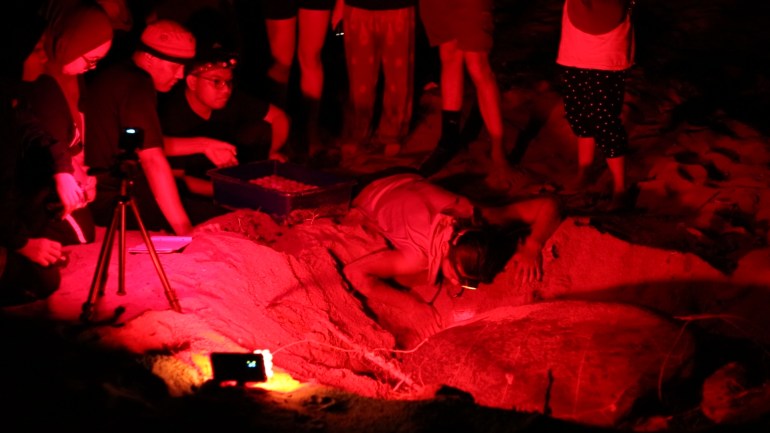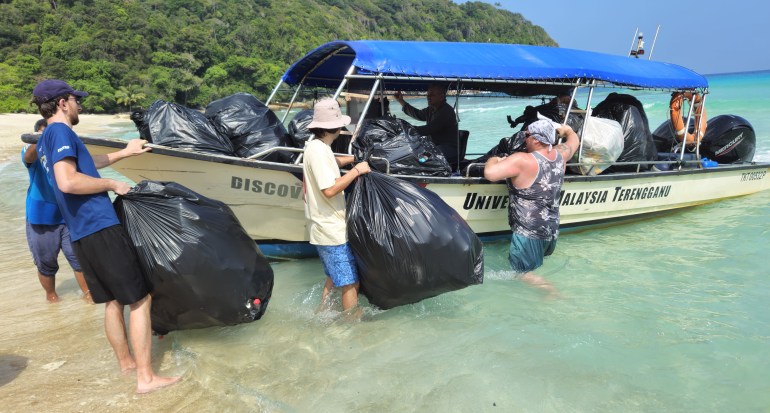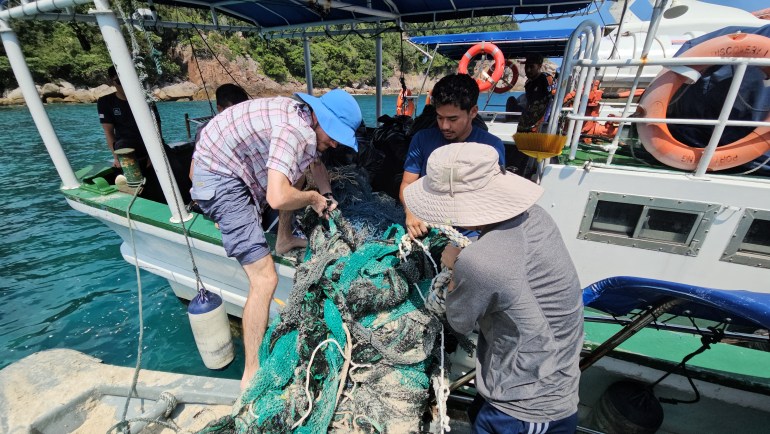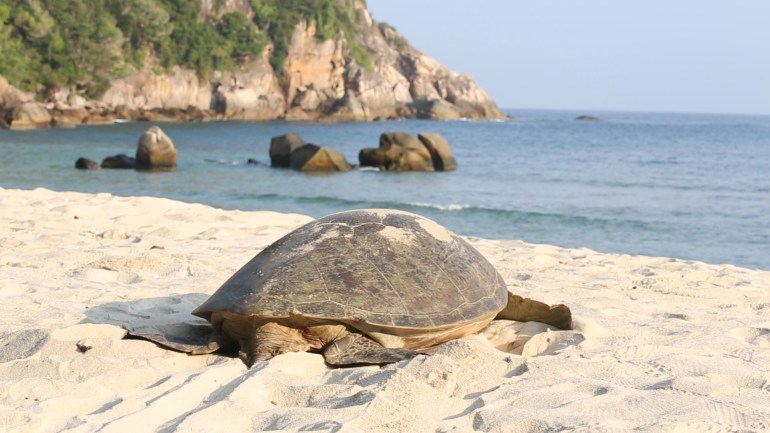Turtles swimming to extinction in Malaysia as male hatchlings feel heat
Already under pressure from habitat loss and pollution, turtles face an existential crisis from the climate crisis’s record heat.

Redang Island, Malaysia – Under a full moon, a bulbous creature emerges from the South China Sea onto a quiet beach on the Malaysian island of Redang.
Watched closely by a team of volunteers, the green sea turtle moves slowly up the fine white sand to the top of the beach, using its flippers to dig into the sand before laying its precious cargo of eggs.
Keep reading
list of 4 itemsAustralia’s Great Barrier Reef suffers worst bleaching on record
‘On borrowed time’: World marks new global heat record in March
Global water crisis fuelling more conflicts, UN report warns
The watchers, from the Chagar Hutang Turtle Sanctuary in the northeastern state of Terengganu, creep close, recording the number of eggs and measuring the turtle as she nests on the sand.
“Redang is known for its turtles. We want to protect our treasure here,” Muhammad Hafizudin Mohd Sarpar, 24, a ranger at the sanctuary, told Al Jazeera a little later that night.
But such sights might soon become a thing of the past as Malaysia’s already endangered sea turtles face a new threat from the rising temperatures caused by climate change. Scientists in the Southeast Asian nation say the heat is warming the sand and disturbing the balance of male and female hatchlings the turtles need to survive.

Observations from Chagar Hutang, one of the country’s most important nesting sites, show very few males have hatched from nests in recent years. It is a similar story on other beaches along the east coast.
“For many areas on the east coast of the peninsular from 2019 until 2022, the number of male turtles hatched is almost zero,” Universiti Malaysia Terengganu (UMT) turtle expert Mohd Uzair Rusli said.
“With global warming, this will result in no males being hatched.”
Eggs laid by turtles incubate for as long as 60 days in the sand and are extremely sensitive to temperature.
At 29.2 degrees Celsius (84.6 Fahrenheit), a green turtle nest will result in an equal share of males and females, but a single degree in temperature change can completely shift the hatchlings’ sex in one or another direction.
Uzair said this narrow range was believed to be “an evolutionary adaptation that balanced the advantages of producing both males and females”.
He added that Malaysian beach temperatures were not being monitored, given that turtles nested at random sites even on the same beach, and that UMT relied on sea surface temperature reports over the decades.
The turtles, which when fully grown return to the same beach they were hatched to lay their eggs, already face enormous challenges. On average, only one out of every 1,000 turtle hatchlings will survive the 15-year journey to adulthood. Uzair worries that, with the higher temperatures, one day there may not be enough males in Malaysian waters to mate with the females.
“We predict that if we still fail to see males being hatched, maybe in about 10 to 15 years, turtles may lay their eggs but they won’t hatch,” he said.
Malaysia is home to four species of sea turtles, with the country’s beaches once visited by thousands of the sea reptiles every year, especially in Terengganu.
Their numbers have dwindled over the decades mainly as a result of human activity – from fishing to pollution and habitat loss as well as people stealing their eggs to eat.
As turtle numbers have fallen, environmentalists have scrambled to help Malaysia’s turtle populations recover.

In 1993, the isolated 350m-long Chagar Hutang beach was chosen by authorities as a conservation site to be managed by UMT, with a volunteer programme set up a few years later.
Since then, the university has been recording turtle arrivals and relocating nests away from predators – monitor lizards are partial to the eggs – as well as human threats.
Their efforts have paid off. From a few hundred nests every year in the 1990s, there were a record 2,180 nests in 2022.
But their success is being overshadowed by global warming and other man-made factors.
A record daily sea surface temperature of 21.07C (69.93F) was recorded in March, according to the United States’s National Oceanic and Atmospheric Administration (NOAA).
Last month was also the planet’s warmest March in 175 years of climate data, the NOAA said, warning there was a 99 percent chance that 2024 would be among the top five hottest years on record.
Oceans cover 70 percent of the planet and absorb 90 percent of the excess heat resulting from carbon dioxide and methane emissions produced by the burning of coal, oil and natural gas.
Plastic
Plastic is compounding the problem. Improperly managed waste floating in the oceans will eventually wash ashore, absorbing even more heat and releasing it into the sand.
Volunteers have been trying to clear the rubbish.

One morning in late March, students and university staff gathered on Chagar Hutang to clean the beach. In a single morning, they gathered enough rubbish – rope, nets and plastic – from the South China Sea to fill several small boats.
“We didn’t get anywhere near all of it, and that’s just from a few hundred metres of coastline,” visiting Belgian student Jonas Goemans, 22, told Al Jazeera as the team stuffed the waste into bags and loaded it onto a larger boat to be disposed of on the mainland, some 50km (31 miles) away.
“It’s horrifying, and especially finding it in a place that’s supposed to be a sanctuary, it’s even worse,” Goemans said.
Research from the US-based Florida State University in 2023 found that large amounts of microplastics, fragments of plastic less than 5mm (0.2 inches) in length, could critically raise beach sand temperatures.
The study found samples with a 30 percent concentration – nearly six times the highest-reported amounts – of black microplastics were 0.58C (33F) warmer than sand that was not contaminated with plastic.
Some studies have suggested making sand cooler for nests by shading them, although doing it for hundreds or even thousands would be difficult. Nests under trees risk hatchlings becoming entangled in their roots and could be a target for invading ants.
Improper artificial shading can also prevent rainfall from cooling hot beaches, while excess water unable to evaporate quickly enough could cause fungal infections in the nests.
“It’s going to take a lot of effort to make sure that we’re managing nests to produce hatchlings at cooler temperatures,” said Nicholas Tolen, a researcher and PhD student with UMT.
Vital role
Having existed since the time of the dinosaurs, sea turtles play a vital role in the world’s oceans and marine food chains.
Leatherbacks, for example, control jellyfish populations, while green turtles feed on seagrass beds, stimulating the growth of these saltwater plants.
Among other things, seagrass helps to clean surrounding waters, reduce coastal erosion and provide habitat for small fish and other marine species.

Even before the climate crisis, Malaysia was seeing fewer and fewer turtle landings, particularly of the leatherback, the world’s largest turtle, which is considered critically endangered.
Uzair said the last two leatherback turtle nests discovered in Terengganu were recorded in 2017, with eggs in both found to be infertile. In 1953, there were some 10,000 nests, according to NOAA.
Only a few sites around Malaysia still see large numbers of turtles coming ashore, and total landings are much fewer than generations before.
Even on Chagar Hutang, only the green turtle lands in large numbers with a handful of hawksbills coming ashore there every year. The green turtle is considered endangered, while the hawksbill is listed as critically endangered.
Hafizudin says he cannot imagine a Malaysia without turtles.
A Redang local himself, he says tourism is the island’s main source of income, with visitors arriving primarily to catch a glimpse of its sea reptiles.
“They are like my siblings. Like my second family. When I became a ranger, I developed these feelings for them, especially when I learned they were [in danger] of becoming extinct,” he said.
“If there are no turtles, the tourists will not come. There will be no attraction.”